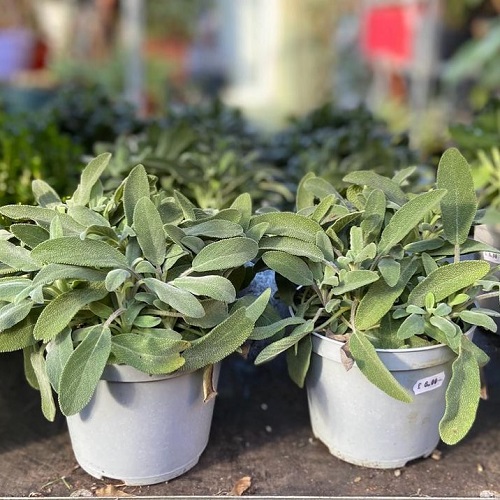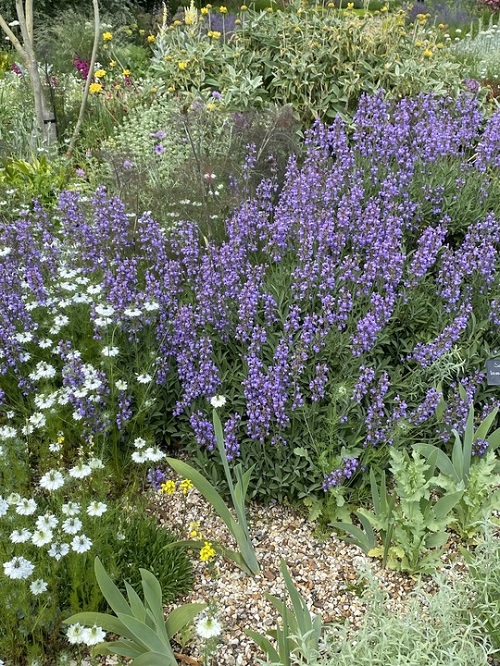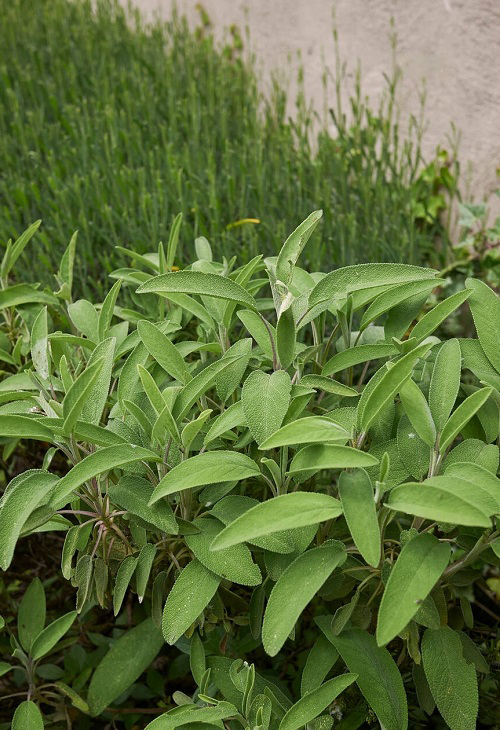Have a look at the best Types of Sage that you can make a part of your garden for a beautiful combination of foliage and flowers!
If you are a fan of beautiful herbs, we have a detailed list of the Best Types of Sage to Grow in Your Garden for you!
Learn Growing Sage in Pots
Best Types of Sage to Grow in Your Garden
1. Pineapple Sage

Botanical Name: Salvia elegans
Pineapple sage has large, lance-shaped green leaves, and clusters of bright red flowers with yellow centers that bloom in late summer and fall. The leaves have a sweet, pineapple-like scent, hence the name.
Find the Best Sage Companion Plants here
2. Golden Sage
Botanical Name: Salvia officinalis ‘Icterina’
It is a compact, low-growing, herbaceous perennial with a clump-forming habit. The foliage is fragrant and aromatic when crushed. In summer, the plant produces small, light blue flowers in whorls along the stems.
3. Common Sage
Botanical Name: Salvia officinalis
It has grayish-green leaves and a woody, perennial stem. The leaves are highly aromatic and are used as a culinary herb. The flowers are small and purple or white in color, and have a long blooming season from May to August.
4. Italian Sage

Botanical Name: Salvia officinalis ‘Italian’
Italian Sage is distinguished by its gray-green leaves which are larger than other varieties, and its long-blooming pink and purple flowers. It is an excellent choice for herb gardens or for adding flavor to foods.
Find the Best Herbs for Pasta here
5. Russian Sage

Botanical Name: Perovskia atriplicifolia
Russian Sage is an attractive plant with silvery-green foliage and produces spikes of small, aromatic, lavender-blue flowers in late summer and early fall. It can be used as an accent plant or as a hedge.
6. Comata Sage

Botanical Name: Salvia viridis var. comata
It is a perennial herbaceous plant in the Lamiaceae family. The herb has fragrant, bright green leaves and produces a multitude of spikes of bright blue flowers. They typically bloom in late spring and early summer.
7. Spanish Sage
Botanical Name: Salvia lavandulifolia
Spanish Sage is a particularly fragrant variety, characterized by its striking clusters of purple-blue flowers and narrow, silvery-green leaves. This hardy plant prefers full sun and is drought tolerant, making it an ideal choice for low-maintenance gardens.
8. Blackcurrant Sage

Botanical Name: Salvia microphylla
Blackcurrant Sage features aromatic, dark green leaves and small, tubular, deep red flowers with a blackcurrant scent. Native to Mexico and the southwestern United States, this bushy, semi-evergreen perennial attracts hummingbirds and butterflies, making it a charming addition to your garden.
9. Broadleaf Sage
Botanical Name: Salvia officinalis ‘Broadleaf’
Its fragrant leaves have a deep, spicy aroma and are often used to flavor many dishes. The flowers of Broadleaf Sage are small, blue-violet in color, and bloom in the summertime. The plant is native to the Mediterranean and Central Asia.
10. Scarlet Sage

Botanical Name: Salvia coccinea
Scarlet Sage is a tender perennial in the mint family native to Central America and Mexico. This plant has long, lance-shaped, light green leaves and produces long, bright red, tubular flowers in the summer.
Look st some Stunning Trees with Red Flowers here
11. Greek Sage

Botanical Name: Salvia fruticosa
Its aromatic leaves are lance-shaped, grey-green in color, and covered with fine hairs. The flowers are purple, pink, or white and appear in summer. It is popular as an ornamental plant in gardens and is also used in traditional herbal medicine.
Looking for Ornamental Grasses? Click here
12. Mountain Sage

Botanical Name: Salvia regla
Salvia regla grows to around 4–5 feet in height, with a spreading habit and gray-green leaves that are slightly toothed. The small, white flowers have yellow centers, and the plant produces purple-black fruit.
13. Mexican Bush Sage

Botanical Name: Salvia leucantha
Mexican Bush Sage is a species of sage native to Mexico and Central America and produces spikes of purple flowers from mid-summer to late autumn. The flowers are attractive to hummingbirds, bees, and butterflies.
14. Mealycup Sage

Botanical Name: Salvia farinacea
Salvia farinacea is an upright, clump-forming perennial that typically grows 2-3 feet tall and is native to Texas and Mexico. Its striking flowers are usually blue but can range in color from lavender to white, and appear on tall spikes in summer.
15. White Sage

Botanical Name: Salvia apiana
Salvia apiana is a shrubby perennial herb native to the southwestern United States and northwestern Mexico. Its grey-green foliage consists of narrow, linear leaves, and it produces white to creamy-white flowers from spring to summer.
16. Woodland Sage
Botanical Name: Salvia nemorosa
It has a clump-forming habit, with square stems and lance-shaped leaves that are gray-green in color. The flowers are two-lipped, with a deep blue calyx and a purple-blue corolla. The flowers appear in summer and are borne in long, dense spikes.






